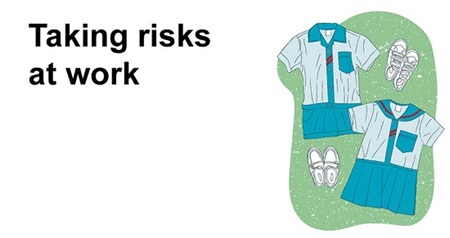Seeing Risk Differently

Innovation can often seem scarier than it is. Especially so in the Public Service, which is why catchphrases like innovative thinking and risk-taking are easily associated with entrepreneurs or technology pacesetters, but rarely with government bureaucrats.
Yet in recent years, here in Singapore, such expectations seem to have extended to public officers too. Panned as “risk averse”, they have been urged to do more than just going by the book, to find fresh solutions to Singapore’s challenges.
While the Public Service is aware of the criticisms, Ms Charlene Han, Deputy Director, Transformation Office, Public Service Division, points out that in fact, Singapore has created many of its own unique solutions. The Electronic Road Pricing system, for example, has influenced congestion pricing in cities across the US, Europe, Brazil and more. By 2020, the gantry system will be updated with satellite technology.
“Now, we’re at a stage of development where we’re forerunners,” Ms Han says. Ironically though, one of the challenges of having achieved some success is that the risks of trying anything new would also be higher. “So, we must guard against inertia.”
Singapore’s public sector is also among the first to trial autonomous vehicles, provide electronic applications for passports, automate clearance at border checkpoints, and use Workplace, the enterprise version of Facebook. The healthcare sector has come up with many innovations too, including the filling of prescriptions by robots, and the use of sensors to monitor the health and care of elderly in their homes. Through tie-ups with the infocommunications and transport authorities, SingPost was the first to trial postal delivery by drone.
But innovation is not limited to technology only. At the Lien Centre for Social Innovation, Executive Director Jonathan Chang is working with the National Council of Social Service on projects to retain talent and increase the capacity of the social sector. “I see first-hand how responsive and attentive our public sector is to social issues,” says Mr Chang.
On labels of the Public Service being risk averse, he says: “There may be some truth to it, but I think the public don’t understand that as a large organisation, the Public Service cannot implement things really quickly without affecting the system in a big way. “I think the word is not ‘risk averse’ but ‘cautious’, because when it comes to implementing changes, the public sector can’t do things too rapidly… And often this is in the best interest of the public, not to be reactionary to everything.”
Be part of the disruption
Indeed, many innovations started in the Public Service have been forward-thinking responses to anticipated needs.
The Immigration and Checkpoints Authority (ICA) is charging ahead with many home-grown innovations. It started exploring the integration of automation and biometric verification at checkpoints as early as 1997, when it realised that employing more manpower alone would not be sufficient to cope with the increasing volume of travellers crossing our borders daily.
That saw the ICA introducing the world’s first Immigration Automated Clearance System, which used a smart card to verify identities. The passport replaced the smart card in 2006.
Following that success, BIKES, or the Biometric Identification of Motorbikers, is the first system in the world to use biometric technology to automate the clearance of motorcyclists and their pillion riders at land checkpoints. Over the years, the convenience of automated clearance has been made available to more travellers, including foreigners residing here on long-term immigration passes, as well as those travelling by foot and by bus.


Regulatory sandboxes
The Monetary Authority of Singapore (MAS) in 2016 allowed financial institutions or start-ups to test new products or services in the market, within defined boundaries. Depending on the project, the MAS will relax specific legal and regulatory requirements, while including appropriate safeguards to contain the consequences of failure. Since then, the MAS has allowed mobile insurance company PolicyPal to distribute insurance to consumers through its app in a sixmonth trial.
Ms Kelly Lim, Deputy Director, Planning & Review Division, at the ICA, says: “The drivers behind our innovations over the years have been both internal and external. With an evolving and highly unpredictable operating landscape, we cannot afford to be satisfied with the status quo. While there may be challenges, there are also opportunities.”
In the transport sector, new, disruptive technologies such as autonomous vehicles, on-demand public transport options, drones, personal mobility devices and ride-sharing services like Uber have emerged to present Singapore with many opportunities to create a public transport system that is efficient, comfortable and convenient.
To scan the environment, tap these new technologies and prepare early for their potential adoption, the Ministry of Transport (MOT) and its statutory boards, including the Land Transport Authority (LTA), have futures divisions that study the possibilities of the future.
Mr Lam Wee Shann, Group Director for Technology & Industry Development at the LTA, says: “There are a number of futures units [across the Public Service]… dedicated set-ups tasked with looking at emerging, disruptive trends and technology, their possible future impact to Singapore and what we should do to prepare for them and be ready when they occur. In that context, we are not risk averse at all.”
Embrace risks, one step at a time
As a regulator, the LTA aims to take a balanced approach to encourage innovation, yet not endanger the public. “There’s a responsibility to put up safeguards,” says Mr Lam. The approach is to “embrace and manage” new technologies, looking at how to regulate while still allowing new devices and technology to “co-exist among all stakeholders with rules and guidelines”.
Early trials of autonomous vehicles are conducted in a “live” environment rather than in an artificially controlled one. At the one-north business park, a 12 km-long road network serves as a test bed for the vehicle prototypes’ various technical capabilities. “With jaywalkers, illegal parking… it’s a live environment, but not as complex as housing estates or a busy CBD, where breakdowns can cause jams,” says Mr Lam. The autonomous vehicles also have to pass a safety test before they can be part of the trial at one-north business park.
“The way to be innovative is not to reject, but take baby steps even when there are no standards,” he adds. “We are also learning to develop a regime of regulation in tandem – for now, a safety driver is required to take over control if the car is not performing. A phased approach helps us achieve new milestones in risk-taking, such as removing the safety driver later. It’s a work in progress.”
Similarly, when the ICA has new initiatives or projects, it starts by implementing them on a smaller scale first, says Ms Lim. “We adopt a phased approach by implementing new projects at one or some smaller checkpoints before we gradually roll out to all. This allows us to take in the lessons learnt in the initial implementation and fine-tune the system or process as we phase in the full implementation.”
The ICA calls this being “risk aware” instead of risk averse, managing risks by “taking innovative steps in a calibrated manner”. Its next big project is to automate the clearance of car drivers and passengers. It is now working on a six-month proof-of concept trial, with ICA officers as users, to fine-tune the design. “Thereafter, we will be taking steps to look into the systems interface. When ready, we intend to conduct live testing with real travellers, albeit in a controlled environment,” says Ms Lim.
But think big

Like the ICA, the Integrated Health Information Systems (IHiS), the technology agency for Singapore’s healthcare sector, faces manpower constraints and rising workload, but with the added urgency of meeting the needs of an ageing population.
Mr Ong Leong Seng, Director of the IHiS Delivery Group, says: “We do take calculated risks, being mindful that we are dealing with patients’ lives. Safety is our top priority.”
The IHiS developed an award-winning Health Cloud IT platform that enables healthcare workers across the public healthcare institutions to quickly and seamlessly access a national database of electronic patient records. Individuals can securely access their health data via SingPass on HealthHub, a digital service that the IHiS developed with the Health Promotion Board.
With all that data, the IHiS is exploring precision medicine, looking at how IT might enable and support personalised dosages of medicine for certain medical conditions – right down to the composition of ingredients, even if such a reality might only be in the “distant future”, as Mr Ong describes. Through a network of medical informatics officers, the IHiS also keeps an eye on “moonshot” healthcare that might be possible in 20 to 30 years. One is the use of nanotechnology, or tiny robots, for more targeted cancer treatment.
The IHiS Research, Innovation & Enterprise Partnership department collaborates with both multinationals and start-ups to flesh out and test new ideas.
“In healthcare, there is always risk in all our projects, as they impact patients’ health. We work closely with healthcare institutions, and our clinical informatics group helps to ensure the clinical quality and patient safety in all health IT deployments,” he adds.
Let ideas collide
Like the IHiS, the LTA works with other public agencies (e.g., the Urban Redevelopment Authority for urban planning, the Economic Development Board to attract foreign partners), and shares its learning experiences with others.
With behavioural experts, for example, the LTA is examining behavioural patterns not only for the vehicles at traffic junctions and road bends, but also those of road users and pedestrians, via CCTV and on-board cameras.
“It’s not LTA and MOT alone. There’s a larger team… we need trailblazers and everybody empowered. Build that culture by walking the talk so others can follow; have an open mind so you can hear feedback,” says Mr Lam.
In fact, a number of public agencies now have platforms to encourage innovation in partnership with members of the public. Hackathons (also called buildathons and makeathons) bring together people of different abilities and experiences to brainstorm and create solutions, and turn good ideas into reality.
The PSD is promoting makeathons as a way to solve challenges, especially those that cut across public agencies. “Makeathons are now quite commonplace but this wasn’t always the case. This requires mindset shifts: to accept that the answers do not lie within ourselves, that we should always see from our end users’perspectives, and where possible, work with them to co-create the final solutions,” says Ms Han.
She adds that this requires learning “new reflexes”, such as making ideas more concrete through prototyping and “being comfortable with testing your imperfect solutions, so that you can fail fast, refine and improve them”.
The PSD makeathons are part of the Excellence through Continuous Enterprise and Learning, or ExCEL, movement, with support from its past and present chairpersons, Dr Beh Swan Gin and Mr Neo Kian Hong. (Read more about changes to ExCEL in A Cuppa With.)
A risky project: Workplace by Facebook
Background: A new digital platform was needed to replace Cube, the Public Service social intranet that was due to be decommissioned. After various options were considered,
Workplace by Facebook came out tops with its familiar user interface, robust mobile app and the company’s track record of frequent feature updates and fixes.
The Singapore government is the world’s first to use Workplace by Facebook.
The risk: Internet Surfing Separation is a security measure put in place to prevent the unauthorised access or transfer of classified data. But “as Workplace is hosted on the Internet, we have taken the stance that only non-classified information should be posted on Workplace. We will need everyone to work together on this,” says Ms Adeline Kwok, Director (Communications) at the PSD.
Mitigating the risk: Workplace champions from various agencies and early pilot users have been role-modelling the desired behaviour, and users can report inappropriate content to the administrators, who also keep a lookout.
Create a culture of support
Behind the ICA’s breakthrough technologies is an innovation framework that calls for a “security-focused, service-conscious” approach, and strong organizational support to explore new ideas.
“Our senior leadership has instilled a culture of being unafraid to question the conventional and doing things innovatively,” says Ms Lim. (Read A Cuppa With... ICA Commissioner Clarence Yeo)
For the transport sector, Mr Lam says: “Management support is very important – from the permanent secretary… so that both the public and private sector address national challenges and how trends can impact us.”
At the IHiS, a big challenge is to lower costs through better and faster technology, as it is not viable for costs to escalate in tandem with increasing medical workload. “There is hence a need to re-orientate how we provide care,” says Mr Ong.
With the Match-A-Nurse service, the IHiS has taken cues from transport sharing-economy apps to match discharged patients with nurses nearby, who can provide follow-up care such as dressing wounds in the patients’ homes.
“Technology alone cannot replace nurses and doctors but it can streamline processes, improve diagnostic tools and procedures… while enhancing the high-touch aspects of patient care and safety,” adds Mr Ong. At the whole-of-government level, the PSD has also taken steps to create a more supportive culture in the Public Service to boost innovation. One is the #DareToTry Innovation Challenge (see below).
To encourage even more risk-taking for innovation, an idea to explore is to celebrate failure as well as success. In its research on innovation and risk, Accenture highlighted advertising agency Grey for its Heroic Failure Award, a trophy given out every quarter to “celebrate failures of daring and audacity” and recognise the clever, unproven ideas that may not work out in practice but still demonstrate creative risk-taking.
After all, when the importance of trying, failing and trying again is embraced, there can only be more good solutions and innovations that emerge.
#DareToTry Innovation Challenge

Public officers can participate in the Open Call (which happens four times a year) where they can surface their ideas, test them and see them through without complex approval channels. They can participate individually or in teams, and stand a chance to receive funding to pursue their ideas.
- POSTED ON
May 12, 2017
- TEXT BY
AJ Leow and Siti Maziah Masramli
- ILLUSTRATION BY
Mushroomhead
-
Deep Dive
Strengthening Singapore’s Food Security
-
Your Say
Taking Risks At Work









